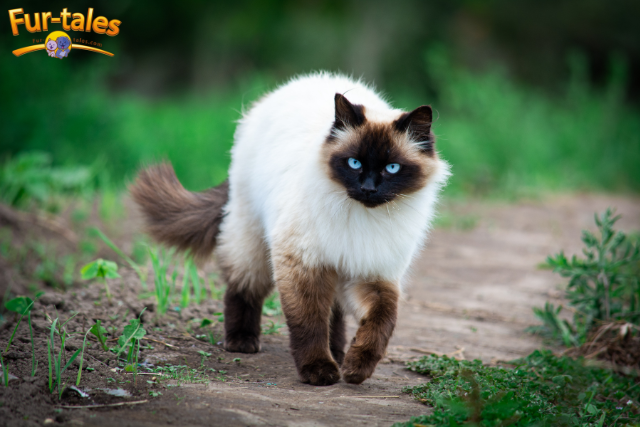
The Origins of the Siamese Cat: From Sacred Temples to Modern Homes
Graceful, vocal, and mesmerizingly beautiful, the Siamese cat is one of the oldest and most recognizable feline breeds in the world. With their striking blue almond-shaped eyes, sleek cream-colored bodies, and distinct color points on their ears, face, paws, and tail, Siamese cats carry both elegance and a rich cultural legacy.
But beyond their beauty and charisma lies a story steeped in history, royalty, mysticism, and evolution. The origins of the Siamese cat are as captivating as the breed itself. In this article, we’ll explore where these fascinating felines came from, how they transitioned from ancient temples to Western households, and what makes them so unique in temperament and lineage.
Ancient Roots: Siamese Cats in Thailand
The name “Siamese” originates from Siam, the former name of Thailand. In Thailand, the breed is known as the Wichienmaat, and its presence can be traced back several centuries—possibly over a thousand years. Siamese cats were highly revered in Thai culture, often appearing in ancient manuscripts like the Tamra Maew or “Cat Book Poems,” dating back to the 14th–18th centuries.
Sacred Guardians
According to legend, Siamese cats were temple cats, believed to guard Buddhist temples and carry the souls of the departed into the afterlife. They were often kept by monks and royal families, living in pampered luxury. These cats were treated with the utmost respect and care, and harming one was considered bad luck.
In temples, it was believed that when a royal or noble died, a Siamese cat would receive their soul and live in the temple in honor of that spirit. The belief added a spiritual reverence that set the Siamese apart from other cats.
Siamese Cats and Royalty
Siamese cats were not only sacred but also symbols of status and wealth. They were exclusive pets of the Siamese royalty and were often given as gifts to foreign dignitaries, adding to their allure and mystique in the West.
Because of their noble status, Siamese cats were rarely seen by commoners and were intentionally bred within palace walls. The careful breeding and limited exposure helped preserve their distinct appearance and personality traits for centuries.
Journey to the West: Introduction to Europe and America
Arrival in England
Siamese cats first gained international attention in the late 19th century. In 1884, a British diplomat named Owen Gould was gifted a pair of Siamese cats by the Thai royal family. He brought them back to England, and they became instant celebrities among cat enthusiasts. Their unique look—striking blue eyes, pale coats with dark points, and slim build—captivated the British public.
The cats were shown at the Crystal Palace Cat Show in 1871, generating both fascination and confusion due to their exotic features.
Crossing the Atlantic
Around the same time, Siamese cats made their way to North America. One of the earliest recorded Siamese cats in the United States was a gift to First Lady Lucy Hayes, wife of President Rutherford B. Hayes, in the 1870s. The cat, named “Siam,” was sent from a U.S. diplomat stationed in Bangkok.
Soon after, breeders began to import and breed Siamese cats, establishing the foundation for what would become one of America’s most popular breeds.
Evolution of the Breed
The original Siamese cat from Thailand had a rounded head, moderate body size, and subtle color contrast. However, as Western breeding programs developed, two distinct Siamese cat styles emerged:
1. Traditional (Applehead) Siamese
- Rounder head and thicker body
- Closer in appearance to the original Thai cats
- Known for a calmer temperament
- Still found in Thailand and with preservation breeders globally
2. Modern (Show-Style) Siamese
- Long, wedge-shaped head
- Lean, elegant body with long legs and tail
- Prominent, large ears
- Sleek and dramatic in appearance
- Most commonly seen in cat shows today
Selective breeding in the West emphasized extreme features for show standards, while traditional breeders worked to maintain the original look of the breed.
Personality Traits and Vocal Legacy
Siamese cats are not just famous for their looks—they’re renowned for their bold, affectionate, and vocal personalities.
Characteristics:
- Highly social and affectionate: They love being near people and often follow their owners around the house.
- Talkative: Siamese cats are extremely vocal and have a unique, low-pitched voice. They’re not shy about sharing their opinions.
- Intelligent and curious: These cats learn tricks, open doors, and can be taught to walk on a leash.
- Attention-demanding: Siamese cats crave human companionship and may become depressed if left alone for long hours.
Because of their outgoing nature, they’re often called the “extroverts” of the cat world.
Coat and Color Points: A Hallmark of the Breed
The Siamese cat’s signature look comes from a genetic mutation that affects coat color. This mutation, called partial albinism, causes the cat’s fur to be lighter on the body and darker on the cooler areas (extremities), such as the ears, face, paws, and tail.
These contrasting areas are known as “points.”
Common Point Colors:
- Seal Point: Dark brown points with a cream-colored body
- Blue Point: Slate-gray points and a bluish-white body
- Chocolate Point: Warm brown points with an ivory body
- Lilac Point: Pale gray-pink points and a glacial white body
As kittens, Siamese cats are born entirely white and gradually develop their color points within the first few months of life.
The Siamese Cat’s Cultural Legacy
The breed’s mystical past and modern popularity have earned it a prominent place in pop culture and literature.
Famous Appearances:
- Disney’s “Lady and the Tramp” featured two mischievous Siamese cats (Si and Am)
- “That Darn Cat!” – a 1965 Disney comedy starring a Siamese detective cat
- James Bond villain Blofeld often appeared with a white Siamese-type cat
- Numerous appearances in books, art, and social media
The Siamese cat has come to symbolize elegance, mystery, and charisma across cultures.
FAQs: Siamese Cat Origins and Characteristics
Q: Are Siamese cats originally from Egypt or Thailand?
A: While Egypt has ancient feline associations, Siamese cats originated in Thailand (formerly Siam). They are not related to Egyptian cat breeds.
Q: Why do Siamese cats have blue eyes?
A: Their eye color is linked to the same gene that causes their coat point pattern. It also affects pigmentation in the eyes, giving them their striking blue hue.
Q: Are all Siamese cats vocal?
A: Yes, most Siamese cats are known for their talkative and expressive personalities, though individual noise levels vary.
Q: What’s the difference between Thai cats and modern Siamese?
A: Thai cats, or Traditional Siamese, have a rounder appearance and milder temperament, while modern Siamese have sleek, angular features and a showier look.
Q: Are Siamese cats good pets for families?
A: Absolutely! They’re loving, loyal, and interactive, but they do best with families who can spend quality time with them.
Image Designed Using Canva
